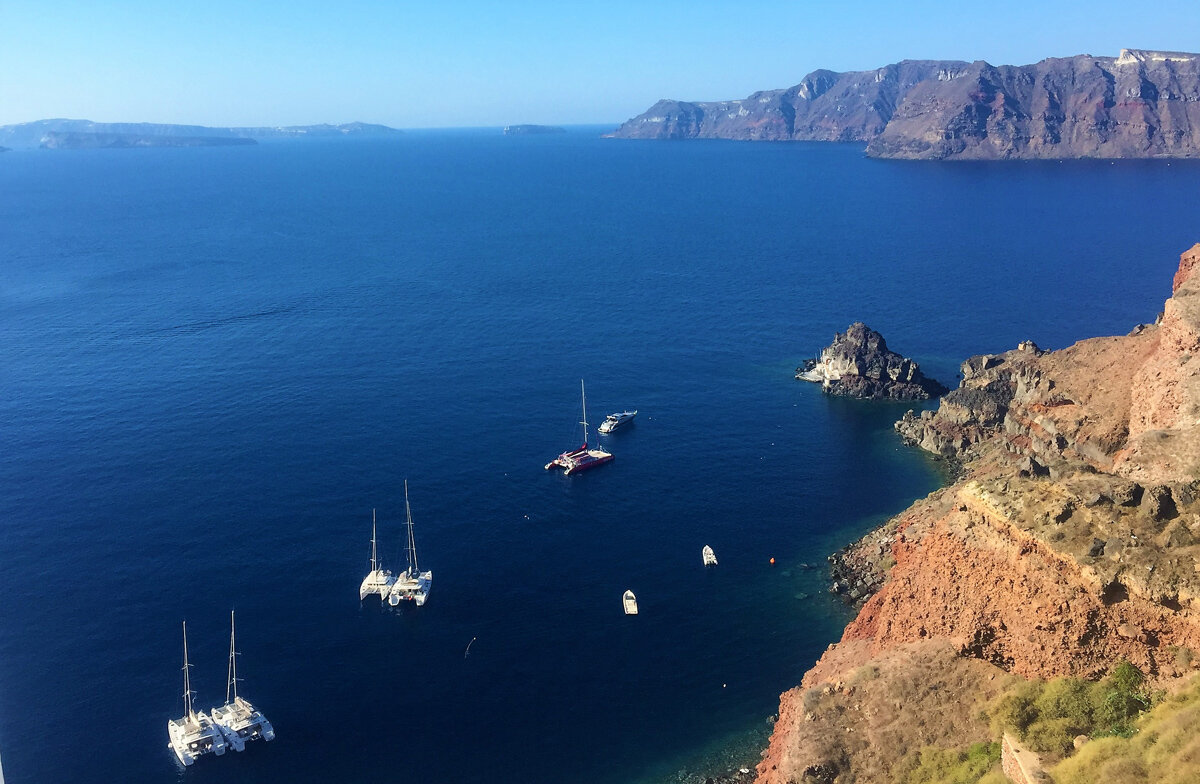Beautiful Santorini at Center of Many Ancient Myths
Photo by Tammy Ulmner
The Greek island of Santorini in the Aegean is a popular stop for cruise ships touring the Mediterranean, and Europeans seeking an exotic island retreat for a week’s vacation. Santorini has a distinctive look not only because of its deep circular harbor that is seven miles across at points, but also because of the glistening whitewashed villages that rest high on the volcanic cliffs that tower above the harbor on three sides.
Most people arrive by boat at the capital of Thera, where there are three choices to reach the cafés and villas awaiting in the town up above. One is to climb up the rocky cliff on more than 600 steps by walking up a series of switchback stairs. Another is to ride up the stairs in a caravan of donkeys. Or, for those people unwilling to trust their fate to a burro or endure a long aerobic workout, you can ride a cable car to the top in five minutes.
Photo by Tammy Ulmner
A Place to Do Nothing
There are many interesting things to do while visiting Santorini. One is to do nothing. From the top of the cliff, you quickly begin to appreciate the scenery and the ambience of the shops and houses that cling to the side of the mountain. There are few places in the world where just sitting in a shady café, and having a cool drink or a glass of wine, is so pleasurable.
Another activity is to visit the ruins of the ancient Minoan city of Akroteri uncovered somewhat intact under 100 feet of volcanic ash on the south side of the island. Apparently abandoned by residents after a series of earthquakes just prior to an ancient eruption, the houses found there contained storage jars, statues and household items. Most visitors focus on the elaborate wall paintings depicting vividly the life of the town’s nobility, their children, agriculture, wildlife and military activities.
Cliff Walk
If outdoor activity is your preference, you can skip the ruins and walk for several miles along the top of the cliff from Thera to Imerovigli or Finikia. Along the way, you can take in the views down to the water, eye the incredible villas and swimming pools that hang out over the edge, and imagine the lives of the people who lived there over the last 35 or 40 centuries.
Despite the natural wonders of Santorini, one questions why so many people throughout the ages decided to settle on the slopes and rim of a large volcano. The volcano there blew up around 1500 B.C. and then collapsed after a massive eruption that left a 1200-foot-deep sea-filled caldera in the middle of the island. Today, the settled population of 15,000 enjoy a casual lifestyle each day and an economy that thrives on tourism and the fertile volcanic soil that produces agricultural products, wine and cement material. The small volcanic island emerging from the water in the center of caldera which is open for tours and “volcanic springs” swimming is a stark reminder that earthquakes and a future eruption are always possible.
Photo by Tammy Ulmner
Mysterious Eruption
Santorini has a mysterious reputation since it has been associated with many myths and legends debated by historians and archaeologists. One theory is that Santorini was the mythical city of Atlantis, later described by Plato in 500 B.C. as an ancient civilization of builders and painters, that was destroyed by fire and submerged beneath the water. A second theory proposed and debated since the 1930s is that the eruption of Santorini and the resulting tsunamis, clouds of ash, and climate change caused the decline of the powerful Minoan civilization based in nearby Crete.
There is general scientific agreement that the eruption of Santorini was one of the four or five largest eruptions to take place during the past 5000 years, and there is evidence of wave and climate damage to the Mediterranean from the event. Nevertheless, some experts now believe that Santorini erupted at an earlier date than previously thought, so it likely took place at least a century before Minoa declined. Finally, there have been suggestions that the exodus of Moses, the plagues of Egypt and the destruction of Pharaoh’s army by a tsunami as described in the Bible and in some Egyptian hieroglyphics, was the result of the Santorini eruption. Considering the cataclysmic nature of the Santorini explosion, it is no surprise that some great events of ancient times are linked to this eruption.



